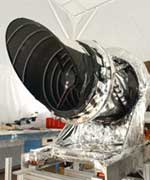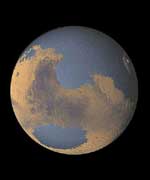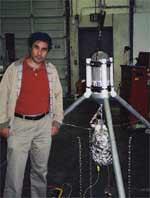NASA has selected eight proposals to provide instrumentation and associated science investigations for the mobile Mars Science Laboratory (MSL) rover, scheduled for launch in 2009. Proposals selected today were submitted to NASA in response to an Announcement of Opportunity (AO) released in April.
The MSL mission, part of NASA’s Mars Exploration Program, will deliver a mobile laboratory to the surface of Mars to explore a local region as a potential habitat for past or present life. MSL will operate under its own power. It is expected to remain active for one Mars year, equal to two Earth years, after landing.
In addition to the instrumentation selected, MSL will carry a pulsed neutron source and detector for measuring hydrogen (including water), provided by the Russian Federal Space Agency. The project also will include a meteorological package and an ultraviolet sensor provided by the Spanish Ministry of Education and Science.
“This mission represents a tremendous leap forward in the exploration of Mars,” said NASA’s Deputy Associate Administrator for the Science Mission Directorate, Dr. Ghassem Asrar. “MSL is the next logical step beyond the twin Spirit and Opportunity rovers. It will use a unique set of analytical tools to study the red planet for over a year and unveil the past and present conditions for habitability of Mars,” Asrar said.
“The Mars Science Laboratory is an extremely capable system, and the selected instruments will bring an analytical laboratory to the martian surface for the first time since the Viking Landers over 25 years ago,” said Douglas McCuistion, Mars Exploration Program director at NASA Headquarters.
The selected proposals will conduct preliminary design studies to focus on how the instruments can be accommodated on the mobile platform, completed and delivered consistent with the mission schedule. NASA’s Jet Propulsion Laboratory (JPL), Pasadena, Calif., manages the MSL Project for the Science Mission Directorate.
Selected investigations and principal investigators:
— “Mars Science Laboratory Mast Camera,” Michael Malin, Malin Space Science Systems (MSSS), San Diego, Calif. Mast Camera will perform multi-spectral, stereo imaging at lengths ranging from kilometers to centimeters, and can acquire compressed high-definition video at 10 frames per second without the use of the rover computer.
— “ChemCam: Laser Induced Remote Sensing for Chemistry and Micro-Imaging,” Roger Wiens, Los Alamos National Laboratory, Los Alamos, N.M. ChemCam will ablate surface coatings from materials at standoff distances of up to 10 meters and measure elemental composition of underlying rocks and soils.
— “MAHLI: MArs HandLens Imager for the Mars Science Laboratory,” Kenneth Edgett, MSSS. MAHLI will image rocks, soil, frost and ice at resolutions 2.4 times better, and with a wider field of view, than the Microscopic Imager on the Mars Exploration Rovers.
— “The Alpha-Particle-X-ray-Spectrometer for Mars Science Laboratory (APXS),” Ralf Gellert, Max-Planck-Institute for Chemistry, Mainz, Germany. APXS will determine elemental abundance of rocks and soil. APXS will be provided by the Canadian Space Agency.
— “CheMin: An X-ray Diffraction/X-ray Fluorescence (XRD/XRF) instrument for definitive mineralogical analysis in the Analytical Laboratory of MSL,” David Blake, NASA’s Ames Research Center, Moffett Field, Calif. CheMin, will identify and quantify all minerals in complex natural samples such as basalts, evaporites and soils, one of the principle objectives of Mars Science Laboratory.
— “Radiation Assessment Detector (RAD),” Donald Hassler, Southwest Research Institute, Boulder, Colo. RAD will characterize the broad spectrum of radiation at the surface of Mars, an essential precursor to human exploration of the planet. RAD will be funded by the Exploration Systems Mission Directorate at NASA Headquarters.
— “Mars Descent Imager,” Michael Malin, MSSS. The Mars Descent Imager will produce high-resolution color-video imagery of the MSL descent and landing phase, providing geological context information, as well as allowing for precise landing-site determination.
— “Sample Analysis at Mars with an integrated suite consisting of a gas chromatograph mass spectrometer, and a tunable laser spectrometer (SAM),” Paul Mahaffy, NASA’s Goddard Space Flight Center, Greenbelt, Md. SAM will perform mineral and atmospheric analyses, detect a wide range of organic compounds and perform stable isotope analyses of organics and noble gases.
Original Source: NASA News Release




